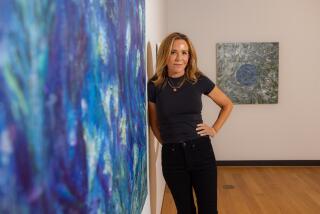Painter seeing a bigger picture
- Share via
PORT CLYDE, Maine — It should have been a summer of normalcy and rest, if not self-congratulations, for Barbara Ernst Prey. She made her usual trek from her main home on Long Island to the peninsula here where over the last three decades she has developed her skills as a watercolorist specializing in bright, uncluttered paintings of the sort of elemental objects -- fishing boats, wildflowers, robust Maine houses -- that have long attracted artists to these parts. Indeed, the popularity of her work has enabled Prey to buy -- for use as a gallery -- the onetime village inn where the late N.C. Wyeth used to come for lunch. Wyeth’s son, Andrew, at 87, still sometimes eats at the dockside restaurant just up Main Street. That’s also where one of Prey’s idols, Edward Hopper, would head off to paint on nearby islands. So here she was in the footsteps of such legends, making a living she could not have dreamed of when she began coming to Maine, joined by her husband, a Presbyterian minister, and their two kids, who relished playing in the sea breezes. Yet hanging in their Blue Water Fine Arts gallery was her painting of a row of blood-red Adirondack chairs in which she sees herself as the chair on the end
As Prey tells it, what left her unsettled, at 47, was success -- a series of high-profile government commissions to be exact. Two were for NASA, which asked her first to paint the International Space Station, then to memorialize the doomed space shuttle Columbia. That watercolor was unveiled last February, not long after 1.5 million households received her other government commission: President and Laura Bush’s 2003 White House Christmas card. For that, she depicted in miniature the White House Diplomatic Reception Room, where Gilbert Stuart’s portrait of George Washington hangs over a fireplace and landscape murals adorn the wall.
In the waning days of her show in Port Clyde, Prey sat on the deck of her gallery, overlooking the waterfront of the fishing village, and spoke of how those jobs had affected her and her work.
*
Question: You’ve said that it was hard to come back and paint geraniums again after doing the White House Christmas card. Why is that? I thought artists could capture the universe in a haystack or a lily.
Answer: I tied that in also with doing the International Space Station. I spent half a year doing all the research. I’m not just going to paint it. I want to know how it looks, how it feels, how it tastes. I read Sky & Telescope magazine. You can see we have a big telescope here. I started to look at the stars. So I’m coming from here and, well, doing the two space paintings, my world has really expanded. Without sounding trite, when you realize how vast the universe is it challenges the small worldview of all of us. It is so vast and utterly awesome that in some ways there is comfort coming back to the familiar. But because of the experience, the familiar is viewed in a different way.
*
Q: Painting everyday objects -- like the Adirondack chairs or quilts on a clothesline -- seemed less significant?
A: Some of it. Once you’ve done something you want to move on, you want to test yourself. You know, I love the chairs. They’re such a symbol of Maine and summer. But some of the things don’t seem so important. The same thing happened after 9/11. What am I doing? I have X number of years in my life. Am I making a difference?
*
Q: But couldn’t you make the case that the White House, as a symbol of society’s pomp, may be less significant than a fisherman’s boat?
A: I guess I was looking at it more from a painting standpoint. When you’re commissioned by the White House there’s a huge amount of pressure, and I was doing something I’m not comfortable doing. If you look at my paintings they have huge blue skies and this was an interior. It could be anyone’s house or room. It’s like you’re a portrait painter and then all of a sudden you’re doing landscapes. In this instance I became a portrait painter, a landscape painter with the mural and an interior painter with the room. And I had to pull it off.
*
Q: And you’re seeing your surroundings differently as a result?
A: I see out here all these ideas, but they’re really busy. If you can see that first shack [she pointed toward the waterfront] there’s all this stuff. I don’t know the person, but he’s got these buoys hanging, this dog dish, he has these tomatoes. To me it’s really a portrait. Who is this person? It’s the outside portrait of who he is.
*
Q: Speaking of people’s lives, things seem to have broken well for you with the high-profile commissions, a supportive husband and all. Yet you have that end chair on the painting you call “Family Portrait” on the verge of toppling. Is that really you?
A: That was last year when I had the deadline for the Christmas card and was working on the Columbia and my mom has Alzheimer’s and she came and lived with us. It was more the concept of the family at a very sad moment. Life is like that. We always try -- we want those chairs lined up. But they’re never going to be lined up.
*
Q: How did you come to show your work in the middle of nowhere?
A: I came up to Maine 27 years ago with a good friend from college. She wanted to have a show at the local Grange. And the people came, people bought. I think I sold a large painting for $175. The area was an inspiration to me and I kept coming back. Now our family comes here and I do a lot of looking for future ideas. It’s inspiration, it’s family time, and it also happens to be a time to show my work. It is kind of funny -- this is at the end of a road, but I’ve come to a point where if people are interested, they come here. I’ve had people come by boat and land a helicopter here.
*
Q: Your college friend was hoping to become your agent?
A: Yes, but she went to Harvard Law School and had a much more lucrative career.
*
Q: But isn’t government work supposed to pay off in the long run, like it does for politicians? You know, you do it for next to nothing, then cash in when you reenter the private sector. Couldn’t you double what you asked for your paintings after being anointed as a favorite of the president and his wife?
A: My fee for the Christmas card was nothing. The payoff was going to the White House and seeing the paintings and the furniture. I haven’t doubled my prices -- but they were raised a bit.
*
Q: So what new ideas did hit you this summer?
A: I’ve been looking around. My radius is so small, but I’m thinking of working Maine, the working harbor and that I hope it’s not going to be a piece of history. There are a lot of trawlers in the harbor, but their days have been cut down. How long will these people be lobstering before all the real estate is bought up by the New Yorkers? I just see this as such a slice of a life I’d like to take a closer look at. We’re looking at something beautiful, but you know what, this is a really hard life.
*
Q: Getting back to geraniums, is it true you once painted some for a dying man?
A: He was from Manhasset [on Long Island]. When he found out he had Lou Gehrig’s disease, his wife asked what he wanted and he said he wanted one of my pictures of geraniums. So I went to the lighthouse and did a painting of geraniums that she gave to him for Christmas. I found out after he died that he would sit in his wheelchair and look at my paintings. He would just line the paintings up. It was just very moving. So that ties in with your work is on multiple levels. It’s not only making a living. That sounds so un-New Yorky.
Soon after Prey spoke, it was time to pack up the paintings and get back to New York, so the kids could return to school and her husband to his church. But then came a hitch in her plan to paint those scenes fresh in her mind. “I just had a call from NASA,” she reported days later. The space agency wanted her to paint the farthest thing from a Maine landscape -- the X-43, its new hypersonic “scramjet” research vehicle. How could she resist that “new challenge,” even if it means flying out to California for a test flight late this month or in November? But until then she’s relishing her idea of normalcy, taking a jaunt up to Nova Scotia, then back to Maine, “exploring the life of the fisherman, observing from my perch,” she said, “in Port Clyde.”
More to Read
The biggest entertainment stories
Get our big stories about Hollywood, film, television, music, arts, culture and more right in your inbox as soon as they publish.
You may occasionally receive promotional content from the Los Angeles Times.










